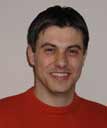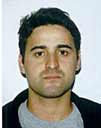Christos LAMPOUDIS
Aristotle University of Thessaloniki
chlab@skiathos.physics.auth.gr

During the last two years, i'm working for my PhD thesis as a member of the n_TOF collaboration. Part of the whole task of n_TOF experiment, is the neutron-induced fission cross section measurements of several isotopes, especially in the energy region where few sets of experimental data exist. Until today I have performed such measurements for Thorium and Uranium isotopes at different neutron energies, using solid state track detectors (lexan) and surface barrier detectors (Si). The measurements were carried out at 5,5MV Tandem accelerator of NCSR (Demokritos, Athens). I have also participated in fast neutron background measurements that took place at the n_TOF facility(CERN).
Sandrine LAPLACE
Laboratoire de L'accelerateur Lineaire - LAL, IN2P3-CNRS et Universite Paris Sud
laplace@lal.in2p3.fr

Christophe LE MANER
LAPP, Annecy-Le-Vieux
Christophe.Le-Maner@lapp.in2p3.fr

Federica LEGGER
IPHE - UNIL, Lausanne
federica.legger@iphe.unil.ch

Damir LELAS
DESY ZEUS/F1 - Deutsches Elektronen Synchrotron, Hambourg
lelas@mail.desy.de

Jessica LEVEQUE
Centre de Physique des Particules de Marseille (CPPM)
jleveque@cppm.in2p3.fr

Wolfgang LIEBIG
Wuppertal University
Wolfgang.Liebig@cern.ch

For my Ph.D. thesis I am working with DELPHI,one of the four LEP collaborations. I have performed a measurement of the b cross-section ratio at LEP2 energies, before I joined the group finalising the inclusive measurement of the Z pole forward-backward asymmetry. The analysis uses a self-calibrating neural network technique combining mainly jet- and vertex charge information to identify the b quark charge. The continued work on this measurement is motivated by new tools developed lately, by the high precision that can be reached and by the good sensitivity to the leptonic weak mixing angle. During the last two years of LEP running I have also done central shifts at the experiment and on-call duties for the vertex detector.
Antonio LIMOSANI
School of Physics, University of Melbourne
antonio@physics.unimelb.edu.au

I am working on the Belle experiment at KEK in Tsukuba, Japan. I have been analysing charmless semileptonic decays of B mesons, with the aim of measuring the magnitude of CKM matrix element V(ub). The method examines the charged lepton momentum spectrum near and beyond the end point for charmed semileptonic decays which are more numerous. This measurement along with others will help to test the Kobayashi-Maskawa mechanism for CP violation within the Standard Model. I have also contributed to the production and testing of the Silicon Vertex Detector (SVD) for Belle. The SVD plays a crucial role in the measurement time dependent CP asymmetries by being able to resolve the separation between the neutral B meson decay vertices.
Else LYTKEN
Niels Bohr Institute, Copenhagen
Else.Lytken@cern.ch

My Phd project is with the ATLAS detector, my main interest being the prospects of supersymmetry searches with this detector. For two months in the beginning of my study I participated in the production of barrel modules for the Transition Radiation Tracker, the outer tracker of ATLAS. Later I have been involved with the geant4 digitization code for this subdetector, and compared read-out properties of data from a 25ns bunch spacing test beam with our Monte Carlo. As for Spring 2002 I am currently working at Fermilab looking for supersymmetry in CDF's Run II data, exploring trilepton signatures.